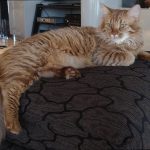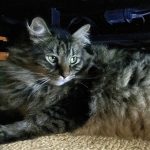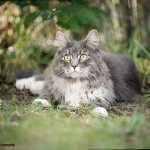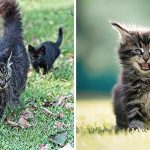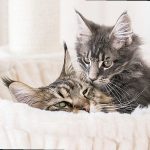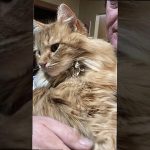Have you ever found yourself gazing at a cat, mesmerized by the little tufts of fur on their ears? These adorable creatures are none other than Maine Coon cats, one of the most ancient and recognizable breeds in existence. But let’s cut to the chase: do Maine Coon cats have ear tufts?
Maine Coon cats are renowned for their distinct physical features, from their large bodies to their long, bushy tails. However, it’s those tufted ears that really set them apart. These aren’t just there for show – they actually serve a purpose. As lively and intelligent creatures originally bred in northern America’s harsh Maine region, these felines needed all the help they could get to survive winter’s icy grip. Their thick coats and tufted ears made all the difference.
In this blog post, we’ll delve into the fascinating history of Maine Coon cats and explore why their ear tufts are such a crucial part of their survival strategy. We’ll also examine the different types of ear tufts out there and uncover why some Maine Coon cats have them while others don’t. So buckle up and get ready to learn everything you ever wanted to know about these fluffy felines – including whether or not they have those coveted ear tufts.
Why Do Maine Coon Cats Have Ear Tufts?
Maine Coon cats are known for their striking appearance, with their long, bushy tails, impressive size, and most notably, their ear tufts. These long hairs that protrude from the tips of their ears are a distinctive feature of the breed. But why do Maine Coon cats have ear tufts?
One theory is that the ear tufts serve a practical purpose in protecting the cat’s ears from the cold and wet weather. As Maine Coon cats originate from the northeastern United States, where winters can be harsh, the ear tufts may provide additional insulation and help keep the cat’s ears warm and dry. This adaptation may have developed over time through natural selection and genetic mutation.
Another theory is that the ear tufts serve a social function. Maine Coon cats are known for their friendly and sociable nature, and the ear tufts may be used to communicate with other cats. Cats use body language to communicate, and the ear tufts may enhance or emphasize certain signals. For example, if a Maine Coon cat is feeling threatened or aggressive, it may flatten its ears against its head, making the ear tufts more prominent and adding to its intimidating appearance.
It is also possible that the ear tufts simply evolved as a result of genetic variation. Unlike many other cat breeds, Maine Coon cats are a natural breed, meaning they were not selectively bred for specific traits. As a result, they may have developed certain physical characteristics like ear tufts through natural selection and genetic mutation.
Regardless of the reason why Maine Coon cats have ear tufts, there’s no denying that they add to their unique appearance. Ear tufts can vary in length, thickness, and color depending on the cat’s coat color and pattern. Some cats may have long, thick tufts that stand out prominently from their ears, while others may have shorter, more subtle tufts that blend in with the rest of their fur.
How Do Ear Tufts Vary in Length, Thickness, and Color?
These small clumps of fur that sprout from the tips of their ears are not just a fashion statement but also serve a practical purpose in protecting their ears from harsh weather conditions. However, not all Maine Coon cats have ear tufts, and those that do may exhibit variations in length, thickness, and color that make each cat uniquely beautiful.
Let’s start with length. Maine Coon cat ear tufts can range from just a few millimeters to several centimeters in length. The length can differ not only between individual cats but even between the left and right ears of the same cat. Some Maine Coons have short tufts that barely peek out from behind their ears, while others boast long, luxurious ear feathers that add to their majestic appearance.
Moving on to thickness, some cats have thick and bushy ear tufts while others may have thinner and more wispy tufts. The thickness of the ear tufts is related to the overall texture and thickness of a cat’s fur. So, if your Maine Coon has thick fur, they are more likely to have thick ear tufts that add to their regal appearance.
Finally, let’s talk about color. While Maine Coon cat ear tufts usually match the color of the rest of their fur, there can be variations within the tufts themselves. For instance, a black-furred Maine Coon cat may have gray or white ear tufts that bring out the beauty of their coat even more.
What Is the Purpose of Ear Tufts on Cats?
In fact, they serve several important functions that you may not have realized.
First and foremost, one possible function of ear tufts is to provide protection for a cat’s ears. These tufts of fur that extend from the tips of the ears can help shield the ears from debris, such as dirt and dust, that might enter the ear canal and cause irritation or infection. Additionally, ear tufts may help to muffle sound and reduce wind noise, making it easier for the cat to hear prey or potential threats.
But there’s more to it than just protection. Ear tufts can also serve as a visual cue during communication between cats. Since cats use body language and vocalizations to communicate with each other, the position and movement of the ears can convey a lot of information. Ear tufts may make it easier for cats to read each other’s body language by providing a more prominent visual cue.
Moreover, in some cases, ear tufts may also be linked to genetic traits associated with specific breeds. For example, the Maine Coon is known for its long, bushy tail, large size, and distinctive ear tufts. These features are all part of the breed’s unique genetic makeup and have been selectively bred over time to create the desired appearance.
How Do Ear Tufts Enhance a Maine Coon Cat’s Unique Appearance?
As a true admirer of Maine Coon cats, you may have noticed their striking appearance, particularly their signature ear tufts. These tufts of fur on the tips of their ears, also known as lynx tips or ear furnishings, are one of the most iconic features of this breed. But what makes them so special, and how do they enhance a Maine Coon’s unique look?
Firstly, let’s talk about aesthetics. Maine Coon cats are known for their rugged and wild appearance, and their ear tufts play a significant role in enhancing this look. These tufts resemble the fur found on the ears of wild cats such as lynx and bobcats. This unique feature gives Maine Coons an impressive and regal appearance that sets them apart from other domesticated cat breeds.
But these ear tufts aren’t just for show; they also serve a practical purpose. They protect the cat’s ears from cold weather, wind, insects, and other potential irritants. The fur acts as a barrier, keeping the cat’s sensitive ears warm and safe from harm.
Moreover, ear tufts can improve a Maine Coon’s hearing abilities. The fur on their ears acts like miniature sound receptors that help funnel sound waves into their ears and enhance their hearing sensitivity. For outdoor cats that rely on their hearing to detect potential prey or threats, these ear tufts are especially important.
How Can Owners Care for Their Cat’s Ear Tufts?
These long hairs growing from the tips of their ears are a defining characteristic of the breed, and they need special care to keep them healthy and looking their best. As a responsible pet parent, you must provide the right care for your cat’s ear tufts.
Here are some tips that can help you care for your Maine Coon cat’s ear tufts:
- Brushing: Regular brushing with a soft-bristled brush is essential to remove any dirt or debris that may have accumulated in the hair. However, be gentle while brushing as ear tufts can be sensitive, and excessive combing or brushing can cause discomfort.
- Inspection: As a cat owner, it is your responsibility to regularly inspect your cat’s ear tufts for signs of infection or irritation. If the ear tufts appear red, swollen, or have a foul odor, it may be an indication of an infection. It is crucial to consult with your veterinarian if you notice any signs of infection in your cat’s ear tufts.
- Keep It Clean and Dry: It is also vital to keep the area around the ear tufts clean and dry. Wetness or moisture can lead to bacterial growth, which can cause infections. Always wipe the area around the ear tufts with a soft cloth if it becomes wet or dirty.
- Avoid Trimming: The hair on the ear tufts provides protection for the ears and helps to keep them warm during cold weather. Thus, it is recommended not to trim your cat’s ear tufts unless necessary. However, if the hair becomes too long, it can be trimmed by a professional groomer or veterinarian who is familiar with the breed.
Common Misconceptions About Maine Coon Cats and Their Ear Tufts
If you are, then it’s highly likely that you swoon over their adorable ear tufts. However, there are several misconceptions about these furry felines and their tufted ears that you need to know about.
One of the most common misconceptions is that all Maine Coon cats have ear tufts. While it is true that many Maine Coons do have tufted ears, not all of them do. In fact, some Maine Coons may have only one tufted ear or no tufts at all. The presence of ear tufts is not a defining characteristic of the breed and can vary from cat to cat.
Contrary to popular belief, the ear tufts do not serve a specific purpose such as keeping the cat warm or helping with hunting. While they may provide some insulation and protection from debris, there is no evidence to suggest that they serve any particular function. They are simply a unique physical feature that sets Maine Coons apart from other breeds.
It is also important to note that ear tufts are not exclusive to Maine Coon cats. Other breeds, such as the Siberian and Norwegian Forest Cats, also have tufted ears. Therefore, the presence of ear tufts cannot be used as a definitive way to identify a Maine Coon cat.
How Are Ear Tufts Used in Communication Between Cats?
These features, known as ear tufts or lynx tips, aren’t just for looks. Ear tufts can serve an essential purpose in communication between cats. As an expert in feline behavior, I’m here to tell you all about it.
Firstly, it’s worth highlighting that not all cat breeds have ear tufts. However, Maine Coon cats are well-known for sporting them – and they can grow up to one inch long. But what do these tufts actually do?
Well, when a cat is feeling threatened or aggressive, its ears will flatten against its head. However, if a cat has ear tufts, they remain visible even when the ears are flattened. This can signal to other cats that the aggressor is not backing down and may escalate the situation.
Ear tufts can also be used in play and socialization between cats. During playtime, cats may use their ear tufts to signal to their playmates that they are not being serious and that there is no actual threat. Similarly, when cats greet each other or interact socially, they may use their ear tufts to communicate their mood or intent.
But ear tufts aren’t just about communication – they can also serve as protection for a cat’s ears. The long hairs can help shield the delicate inner ear from debris and insects.
Conclusion
In conclusion, the Maine Coon cat’s ear tufts are a distinctive physical feature that sets them apart from other breeds. These long hairs protruding from the tips of their ears serve a practical purpose in protecting their delicate ears from harsh weather conditions. Furthermore, ear tufts can help reduce wind noise and muffle sound, making it easier for these cats to hear potential prey or threats.
Apart from their practical use, ear tufts also play a significant role in feline communication. The position and movement of the ears convey vital information between cats, and the presence of ear tufts provides an additional visual cue for better understanding.
It is worth noting that not all Maine Coon cats have ear tufts, but for those that do, they exhibit variations in length, thickness, and color that make each one unique and beautiful. To ensure proper care for your cat’s ear tufts, it is essential to regularly brush them with a soft-bristled brush, check for any signs of infection or irritation, keep the area around them clean and dry while avoiding unnecessary trimming.
It is important to dispel some misconceptions about Maine Coon cats’ ear tufts. While they do not serve any specific purpose such as keeping the cat warm or aiding hunting skills, they remain a stunning physical trait that sets this breed apart from others.
